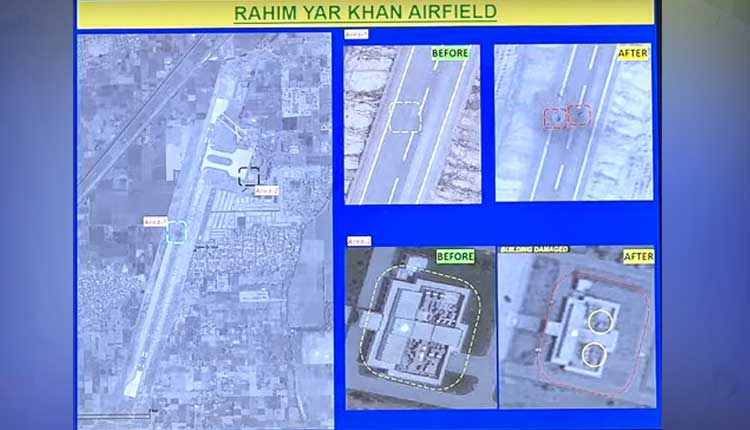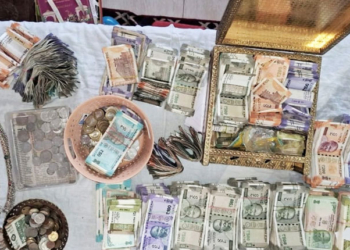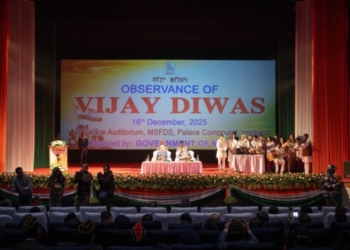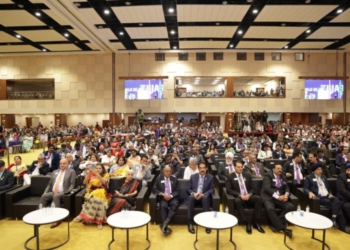New Delhi: The half-burnt portrait of Asif Ali Zardari from the smouldering debris of Rahimyar Khan air base is a symbolic devastation of the image of Pakistan as Operation Sindoor marked a significant demonstration of India’s military and strategic prowess through a blend of military and non-military means.
The extent of Pakistan being punished through both means is now quite clear.
The multi-dimensional operation successfully neutralized terrorist threats, deterred Pakistani aggression, and reinforced India’s zero-tolerance policy toward terrorism, all while maintaining strategic restraint and international support.
As far as the military measures are concerned, India employed a range of precise and deliberate military actions to achieve its objectives.
The Indian Armed Forces carried out coordinated precision missile strikes on nine terrorist facilities—four in Pakistan (including Bahawalpur and Muridke) and five in Pakistan-occupied Kashmir (such as Muzaffarabad and Kotli). These facilities were key command centers for Jaish-e-Mohammed (JeM) and Lashkar-e-Taiba (LeT), responsible for attacks like Pulwama (2019) and Mumbai (2008).
In response to Pakistan’s retaliatory drone and missile attacks from May 7-9 that targetted multiple Indian cities and military installations, India launched kamikaze drones to destroy Pakistani air defences across the country, including neutralising the air defence system of Lahore.
India’s air defence system proved instrumental in neutralising all incoming threats, resulting in near zero casualties or material losses, and exposing flaws in Pakistan’s HQ-9 system. The counter military actions on the night of May 9 and 10 also became the first instance of a country damaging air force camps of a nuclear country.
Within three hours, 11 bases were attacked including Nur Khan, Rafiqui, Murid, Sukkur, Sialkot, Pasrur, Chunian, Sargodha, Skardu, Bholari and Jacobabad.
The scale of destruction was clearly visible in the before and after photos of Shahbaz airbase at Jacobabad.
In the strikes, various ammunition depots and bases like Sargodha and Bholari that housed F-16s and JF-17 fighter jets were hit. This led to destruction of 20 per cent infrastructure of Pakistan’s air force.
India bombed Pakistan’s Bholari Air Base, killing over 50 people including Pakistan’s squadron leader Usman Yousuf, four airmen among others as well as destroying Pakistan’s fighter jets.
Over the course of Operation Sindoor, multiple terror and military locations across Pakistan were attacked by India. Along the LoC, following Pakistani artillery and mortar shelling in the Poonch-Rajouri sector that targetted civilian areas, Indian troops responded with calibrated counterfire destroying terrorist bunkers and Pakistani army’s positions to target civilians.
When it comes to the non-military measures, India’s non-kinetic efforts were equally significant in shaping the strategic environment and ensuring public and international support. India leveraged strategic policy decisions, information dominance, and psychological operations to isolate Pakistan economically and diplomatically, while bolstering domestic readiness and international support.
India’s suspension of the Indus Waters Treaty (IWT) under Operation Sindoor was a decisive move with far-reaching consequences. Pakistan, as the lower riparian, depends on the Indus system for 80 per cent of its 16 million hectares of farmland and 93 per cent of its total water use — sustaining 237 million people and driving a quarter of its GDP through crops like wheat, rice, and cotton.
With just 10 per cent live storage capacity (14.4 MAF) at Mangla and Tarbela dams, any disruption in flows threatens catastrophic agricultural losses, food shortages, water rationing in major cities, and rolling blackouts that would cripple industries, including textiles and fertilizers. These shocks could trigger a broader fiscal and foreign exchange crisis in an already fragile economy.
For India, the treaty had long constrained infrastructure development in Jammu and Kashmir, limiting it to run-of-the-river projects. Its suspension allows India full control over western rivers like Jhelum and Chenab — enabling new reservoirs, boosting irrigation and hydropower in Jammu and Kashmir, Ladakh, Punjab, and Haryana, and transforming a diplomatic tool into a developmental advantage.
By suspending this, India gave decisive message that water and blood cannot flow together.
India closed the Attari-Wagah border and suspended all bilateral trade with Pakistan, halting exports of key goods such as onions and restricting imports like cement and textiles. This decision severed the primary land-based trade route between the two countries.
The suspension imposed immediate economic costs on Pakistan, already grappling with inflation and debt. By choking off these economic lifelines without engaging in direct military escalation, India reinforced its zero-tolerance stance while avoiding full-scale conflict.
India also cancelled the visas of all Pakistanis living in India and sent them back in the immediate aftermath of the April 22 Pahalgam terrorist attack showing strong resolve against terrorism. The imposition of a complete ban on Pakistani artists, halting performances, screenings, music releases, and cultural collaborations also extended to streaming platforms, cutting off Pakistan’s cultural influence in India.
India exposed Pakistan’s terror ecosystem globally and isolated Pakistan diplomatically. These steps imposed tangible economic and diplomatic costs. Collectively, these actions deepened Pakistan’s isolation and reaffirmed India’s commitment to a zero-tolerance stance on terrorism.
(IANS)
















